From commuting on trains to working out in the gym, earbuds have become a constant companion in our daily lives. They’re small, portable, and deliver a private sound experience anywhere you go.
But when were earbuds invented and how did they evolve into the advanced, wireless devices we use today?
In this post, we’ll explore the full earbuds origin story, the key milestones in their evolution, and how they transformed from classic wired designs to today’s smart, AI-powered models.
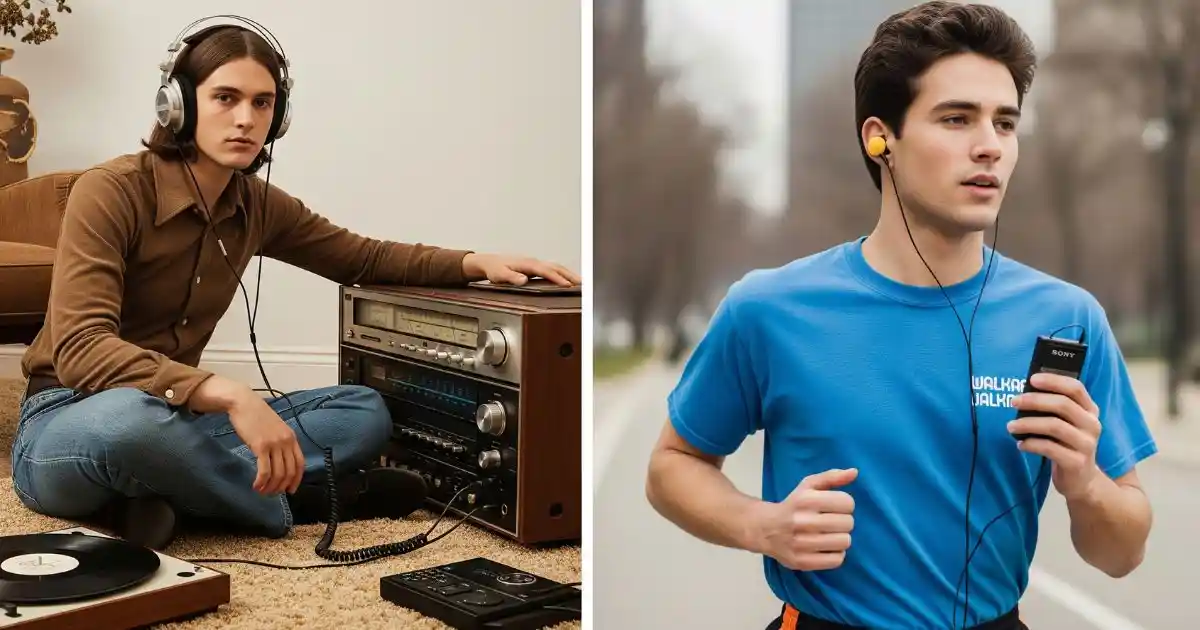
Quick Navigation & Previews
When Were Earbuds Invented?
Earbuds, in the form we know them today, first appeared in 1980 when Sony launched the original Sony Walkman. Until then, most people used big, over-ear headphones that were bulky and not exactly ideal for carrying around. The Walkman changed everything. It was small, portable, and came with a brand-new style of in-ear headphones that we now call earbuds.
Sony’s engineering team designed these first earbuds. They were simple, just small plastic earpieces covered with soft foam for comfort but at the time, this was a big deal. The foam wasn’t just for comfort; it also helped improve the fit and reduce some outside noise. For people in the early 80s, this meant they could finally take music anywhere without feeling weighed down.
I found it interesting that these earbuds weren’t just a tech accessory; they became part of the Walkman culture. People would wear them on buses, while jogging, or just walking through the city, and it signalled, “I’m in my own music world.” The combination of portability, privacy, and style was something completely new.
So, if you’re looking for the official “earbuds invention date”, it’s 1980. And while the design has evolved massively since then, the goal has always been the same: small, comfortable, and perfect for listening on the go.
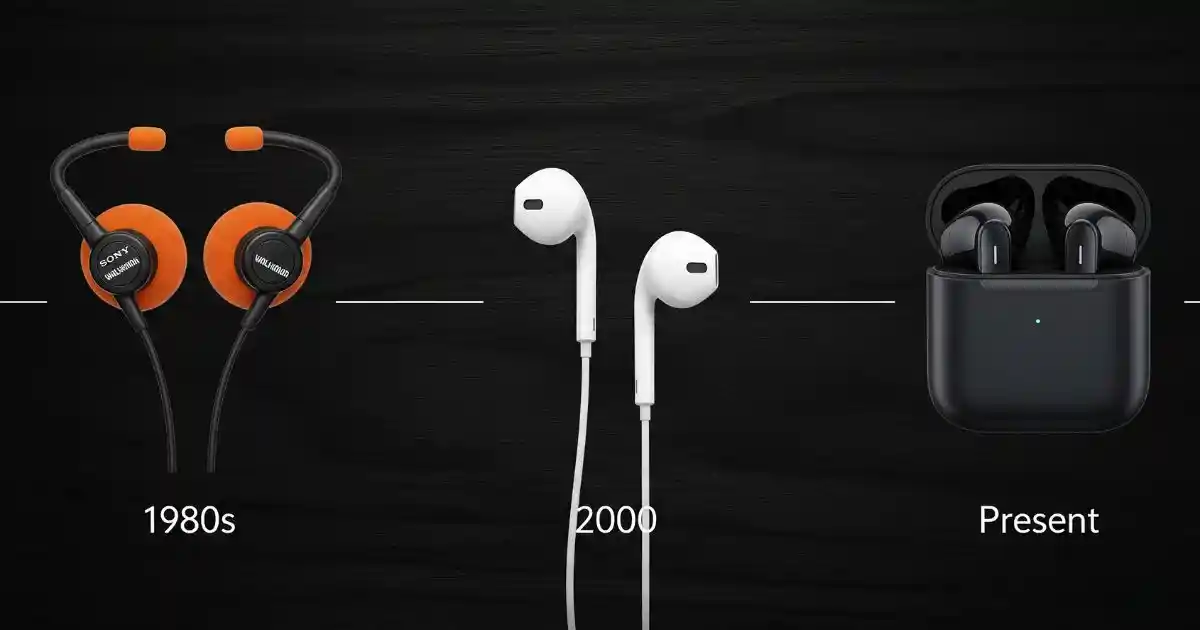
First 5 Notable Consumer Earbuds
- Sony MDR-E252 (1980): The first widely popular consumer earbuds, launched with the original Sony Walkman.
- Sony MDR-E484 (Late 1980s): Known for improved sound clarity and a better fit, popular among audiophiles of the time.
- Sony MDR-E888 (1990s): A premium earbud model with excellent sound detail for portable CD and cassette players.
- Apple iPod Earbuds (2001): Iconic white earbuds bundled with the first iPod, instantly recognizable worldwide.
- Shure E2c (2004): Among the first consumer in-ear monitors (IEMs) designed for better sound isolation and bass response.
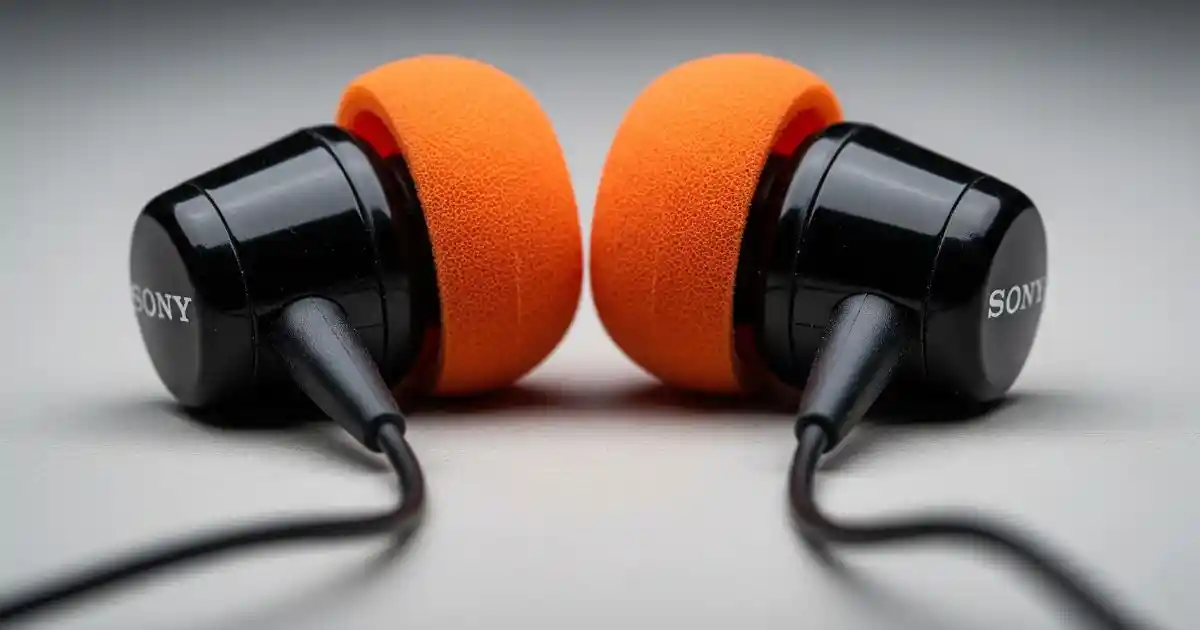
Where Are the First Earbuds Now?
These early models, like the Sony MDR-E252, have become rare collectibles for vintage audio enthusiasts.
Collectors prize them not just for their durability, but also for their unique retro design, a snapshot of the moment when portable music truly became personal. Many audio hobbyists proudly share photos of their old earbud collections online, comparing them to today’s sleek wireless and AI-powered designs.
For fans of music history, owning a pair of these first-generation earbuds is like holding a piece of personal audio history a reminder of how a small innovation transformed the way we listen to music forever.
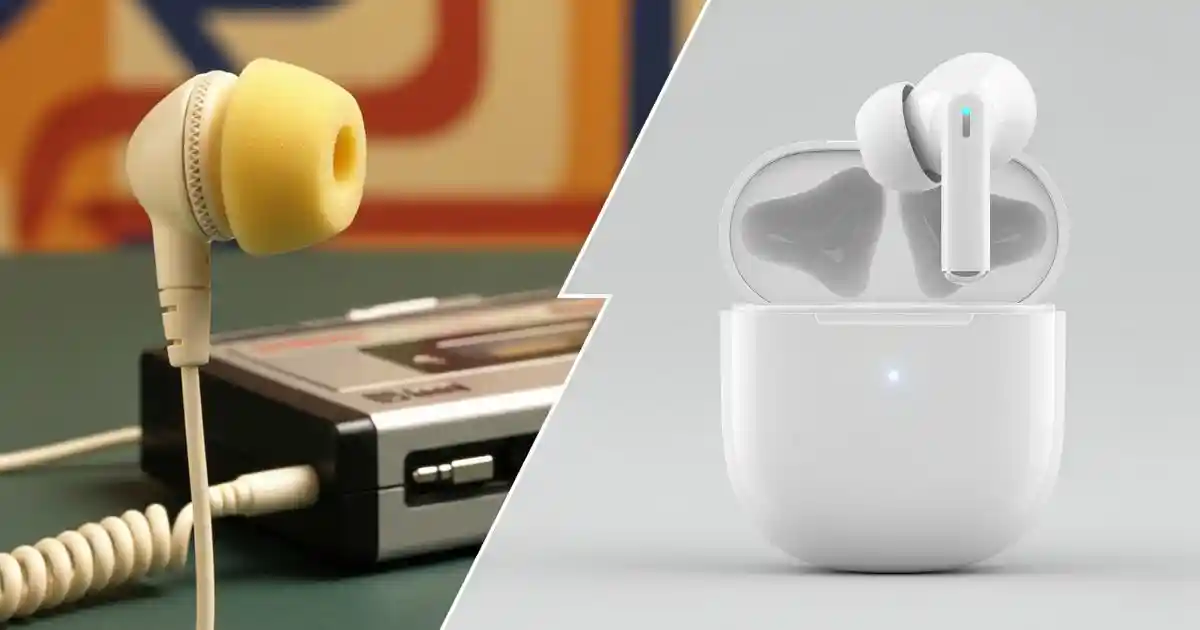
First In-Ear Headphones: How They Differ from Today’s Models
They had no microphone, no controls, just soft foam covers for comfort, and only basic sound quality with limited bass. Still, they were a breakthrough, offering portability that bulky over-ear headphones couldn’t match. Fast forward to today, and modern earbuds, especially wireless models, are packed with features like Bluetooth connectivity, touch controls, active noise cancellation, high-resolution audio, and even AI-powered sound adjustments that adapt to your surroundings.
The first in-ear headphones were basic:
- Wired connection only
- No microphone or controls
- Simple foam covers for comfort
- Limited bass response
This transformation from basic wired buds to smart, feature-rich earbuds shows just how far personal audio technology has advanced in the last few decades. Today’s earbuds, like the best wireless earbuds, offer:
- Bluetooth connectivity
- Touch controls
- Noise cancellation
- High-resolution sound
- AI-powered audio adjustments
Earbuds Evolution Timeline
1980s – The Birth of Consumer Earbuds
Sony changes music forever by releasing the first consumer earbuds alongside the legendary Walkman. These foam-covered, wired in-ear headphones give people the freedom to carry music anywhere, marking the start of truly portable personal audio.
1990s – Comfort and Sound Improvements
As compact disc players become popular, earbud designs evolve for better comfort and improved sound clarity. Manufacturers experiment with different shapes, materials, and driver technology to make long listening sessions easier on the ears.
2001 – The iPod Revolution
Apple launches the iPod, bundled with its now-iconic white earbuds. They become a global fashion statement and a symbol of the digital music era, helping make earbuds a must-have accessory for millions.
2010s – The Rise of True Wireless Earbuds
The industry shifts again with the arrival of true wireless earbuds—no cables at all. Apple AirPods lead the charge, offering easy pairing, portability, and better battery life, while competitors quickly join the race with their own models.
2020s – AI-Powered and Health-Tracking Earbuds
Today’s earbuds go far beyond just playing music. Advanced models feature AI-powered sound adjustments, active noise cancellation, voice assistant integration, and even health tracking features like heart rate monitoring and fitness analysis.
From the foam-covered wired buds of the 80s to today’s sleek, feature-rich wireless designs, the journey of earbuds shows just how rapidly personal audio technology has advanced in the past four decades.
Vintage Earbuds Design & Old Earbud Collections
Early earbuds were built with simple, durable materials like hard plastic or soft foam tips to provide basic comfort. These models typically featured straightforward wired connections without any advanced controls or customization for sound, offering limited bass and treble performance compared to today’s standards.
Collectors and audio enthusiasts often seek out iconic vintage earbuds such as Sony’s MDR series and the original Apple iPod earbuds. These classic designs not only carry nostalgic value but also remain functional, representing an important chapter in the history of personal audio devices.
For those passionate about retro tech, vintage earbuds showcase how far audio technology has come while still delivering a unique listening experience rooted in simplicity.
History of Earbuds & Their Cultural Impact
Before earbuds existed, music lovers relied on large, bulky over-ear headphones that weren’t very portable. The arrival of lightweight, compact in-ear earbuds completely transformed how people listened to music, making it easier to enjoy tunes anytime, anywhere.
Starting with Sony’s Walkman earbuds in the 1980s, followed by Apple’s iconic iPod earbuds in the early 2000s, these small devices quickly became more than just audio tools; they turned into cultural symbols of personal freedom and individuality. Earbuds allowed people to create their private soundscape in public, changing the way we connect with music and even how we experience daily life.
Today, earbuds continue to shape music culture, blending style, technology, and convenience to fit modern lifestyles.
When Did Earbuds Become Popular?
Earbuds gained mainstream popularity in the early 2000s, driven by Apple’s launch of the iPod in 2001. The famous silhouette advertisements featuring white earbuds made them instantly recognizable and highly desirable worldwide.
Their popularity surged again in the late 2010s with the rise of true wireless earbuds, led by the release of Apple’s AirPods in 2016. This marked a shift toward convenience, style, and advanced features, turning earbuds into both a tech essential and a fashion statement.
Sony’s First Earbuds and Their Influence
Sony’s early MDR series earbuds, introduced with the launch of the Walkman in 1980, played a crucial role in shaping the future of in-ear audio. These earbuds were lightweight, comfortable, and designed for true portability qualities that quickly set them apart from the bulky over-ear headphones of the time.
Sony’s focus on ergonomic design, foam-covered tips for comfort, and clear, balanced sound created a new standard for personal listening. This approach influenced nearly every major audio brand that followed, laying the groundwork for the modern earbud market.
Even decades later, the legacy of Sony’s first earbuds can be seen in today’s designs, from wired models to advanced wireless and AI-powered versions. They didn’t just change the way we listen—they changed the way we think about portable music.
What Modern Users Can Learn from Early Earbuds
Early earbuds didn’t have Bluetooth, noise cancellation, or smart features—but they stood out for their simplicity, durability, and comfort. They were built to last, easy to use, and designed for long listening sessions without causing discomfort.
When shopping for modern earbuds, these qualities are still worth keeping in mind:
- Prioritize fit – The right size ensures comfort and better sound isolation.First, get the fit right. The perfect size ensures comfort and better sound. If you have smaller ears, take a look at our picks for the Earbuds for Small Ears.
- Protect your hearing – Don’t forget to protect your hearing. Since modern earbuds can get loud, you should check out How to Prevent Hearing Loss.
- Match sound to your preference – match the sound to your preference. Whether you love deep bass or precise detail, you’ll want to choose accordingly. You can find what you’re looking for in either the Best Bass In-Ear Headphones or Best Audiophile Headphones.
By combining the comfort and reliability of early designs with today’s advanced features, you can enjoy the best possible listening experience.
Conclusion
The journey of earbuds began in 1980 with Sony’s first in-ear models. Over the decades, they’ve evolved from simple wired devices into advanced, wireless companions that integrate with our phones, workouts, and even health monitoring.
FAQs
When were earbuds first invented?
In 1980, by Sony, alongside the Walkman.
Who created the first earbuds and why?
Sony engineers, to make portable music listening more comfortable and lightweight.
Are old earbud collections still available?
Yes, collectors and retro tech fans often share them online or display them in museums.
How have in-ear headphones evolved over time?
From wired foam-covered tips to wireless, noise-cancelling, AI-powered designs.
Why did Sony become a key player in earbud history?
They were the first to mass-market earbuds globally, setting a standard in comfort and portability.
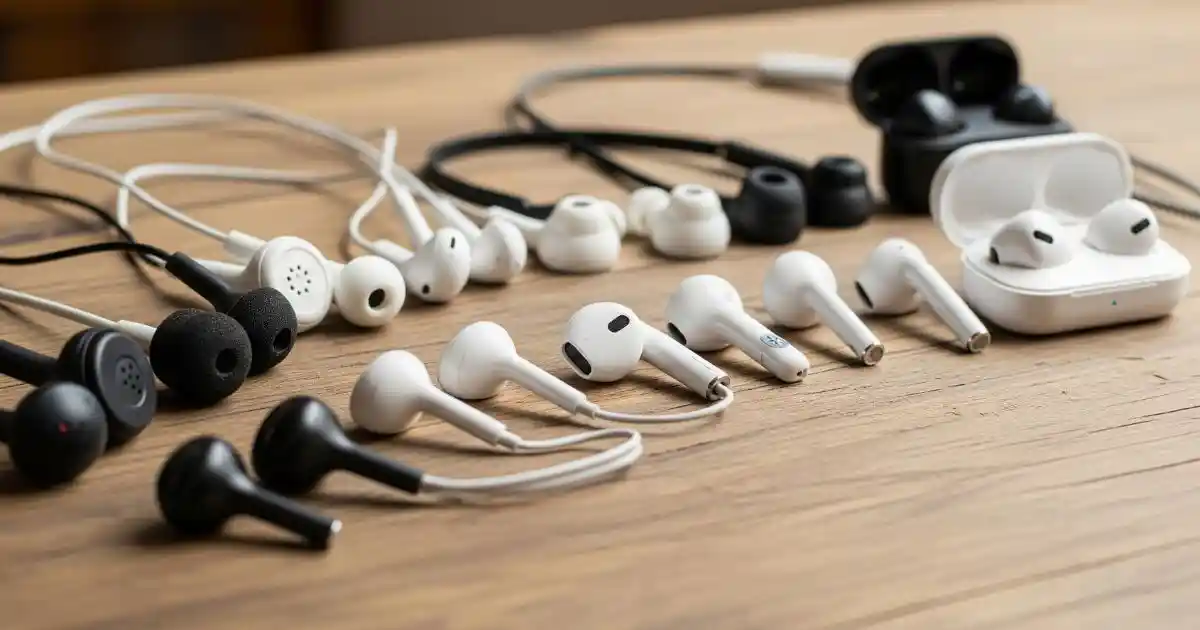
Leave a Reply